2-Week Argentina Itinerary (Plus Chile!) for Your Dream Trip
Trying to plan a 2-week Argentina itinerary can easily turn from exciting to overwhelming. Between culturally-rich cities, world-class wine country, and jaw-dropping Patagonia landscapes, building an itinerary can feel impossible. And with long distances between regions, it’s not always the easiest place to navigate.
I first fell in love with Argentina when I was just 18 studying abroad in the coastal city of Mar del Plata where I lived with a couple of host families. Ever since then, I'd always dreamed of returning to see more.
I finally had the chance to do so in 2022. I didn't know when I'd be back, so you know I was trying to maximize my time there and see as much as I could. Plus, I had initially planned this trip to be my honeymoon, so I was looking for a really special trip with a mix of the best experiences.
This article walks you through my exact 2-week itinerary–designed for travelers who want a balanced mix of vibrant city life, relaxing vineyard days, and some of the most breathtaking hikes I’ve ever done (even with a quick detour into Chile!).
If you’re the kind of traveler who's looking to mix great food, challenging hikes, and culture, then this itinerary is for you. And while I didn't end up going on this trip solo, this trip would be great for solo travelers too.
Plus, I've included some other itinerary ideas to help you customize this to build your own perfect trip!

Itinerary Overview
When my engagement fell apart, I knew I still had to go on this trip, or at least some version of it. This was a trip I had dreamed of for almost ten years. I couldn't not go!
I ended up keeping the trip as planned, and I'm so glad! It's probably my favorite trip of all time and I can't wait to share it with you here in this article.
Here's an overview of what this itinerary includes:
- 3 days in Buenos Aires: tango, steak, and more
- 3 days in Mendoza: wine, wine, and more wine!
- 2 days in El Calafate: one of the world's most spectacular glaciers
- 2 days in El Chaltén: some of Argentina's best hikes
- 3 days in Torres del Paine National Park: some of Chile's best hikes
- Plus all the travel time in between

Days 1-3: Buenos Aires
To get to Argentina, you'll want to hop on an overnight flight to the nation's capital, Buenos Aires. Often called the “Paris of the Americas,” this city has so much to offer and will be a great place for you to start your trip.
I've spent over a month exploring this city and will walk you through how I recommend spending a few days there. For more ideas, check out my other articles detailing itineraries and top activities in the city.

Day 1: Ease Into the Trip with Some Exploring and a Mate Tasting
You're going to be tired after likely a long overnight flight and early morning arrival, but you must push through! For your first day, keep your plans flexible and to a minimum but make sure you force yourself to do something to help you stay awake.
Get Cash and Walk Around Palermo
After you drop your bags at your hotel, you'll want to get some cash before you do anything else. Cash is king in Argentina and can get you better exchange rates at times.
I used Cambio Baires Plaza Italia to exchange $100 USD bills with Argentine pesos. To find out the exchange rate for the day, you can message them on WhatsApp before your visit: +54 11 2625-5252.
Afterwards, I recommend spending time walking around the charming Palermo neighborhoods and parks and gardens in the area like the 17-acre botanical garden Jardín Botánico Carlos Thays.

Try the Iconic Tea All the Locals Drink
For a caffeine boost, consider booking a mate tasting for the afternoon. Mate (pronounced mah-te) is a tea that's so popular it's basically a national symbol of Argentina.
A tasting like this is really the only why to try it out unless you have a local friend. You can't just order mate at a cafe because it's something people prepare themselves.
I did this exact mate tasting during my time in Buenos Aires, and it was one of the highlights of my trip. It's a great way to try this tea and learn more about the culture behind it.
➡️ Book Your Mate Tasting Here

Day 2: Visit Some of the City's Most Famous Neighborhoods and Partake in an Asado
Feel free to sleep in a bit on day 2 to help you feel refreshed and ready to explore! On this day, you'll check out some of the coolest neighborhoods in the city and experience a key part of Argentine culture with an asado.
Shop at the San Telmo Market Street Fair (Sundays Only)
If it's a Sunday, head on over to the San Telmo Market Street Fair. This open air market takes place each week and is a great place to grab a souvenir and see the kinds of things local artisans are making.
You can find all kinds of things from signs with the unique lettering from the city called Fileteado Porteño, to art, vintage clothes, and more.
The market runs along a street Calle Defensa from Plaza de Mayo to Plaza Dorrego. It's typically open Sundays between 10 a.m. and 5 p.m.
If your visit doesn't fall on a Sunday though, you can still visit the San Telmo Market building any day of the week. It'll give you a good taste of what it's like to experience the full open air street market.
TIP: The market can get crowded, especially later in the day. Crowds can increase the risk of pickpocketing, so be sure to stay aware of your surroundings and keep your belongings close.
Visiting this market was one of my favorite parts of my stay in Buenos Aires and definitely something I'll do again whenever I return.

Take in the Colorful Buildings of La Boca
Afterwards, walk over to the nearby neighborhood La Boca. Start on the street known as El Caminito. Full of colorful buildings and impromptu tango shows, it's one of the most special areas to visit in the city in my opinion.
Here you can grab a drink or a bite to eat, check out some of the shops in the area, and maybe see a free tango performance.
Afterwards, it's worth walking by the stadium for the Boca Juniors fútbol team, one of the most beloved teams in the country.

Experience Argentina's Weekly Ritual: Asado
End the day by partaking in an asado. An asado is like a cook out, but it's more than just food. It's a very important part of Argentina's culture and cuisine.
When I studied abroad in Argentina and lived with two different host families, each of them would have an asado every Sunday. It was a special time for them to gather with family and friends while enjoying a great meal.
When I was in Buenos Aires, I had friends partake in this 2.5 hour rooftop asado experience and they highly recommended it. Sadly I ran out of time for it myself but I plan to do it when I return.
If you do one thing in Buenos Aires, I recommend this asado experience.
During the experience, you'll get to try steak, sausages, empanadas, dulce de leche cake, Argentine beverages, and more. And if you're vegetarian, don't worry–they can accommodate vegetarians if you let them know in advance.
While you can get incredible steak easily in many restaurants in Argentina, there's something special about eating steak as part of this local ritual.
➡️ Book Your Asado Experience Here
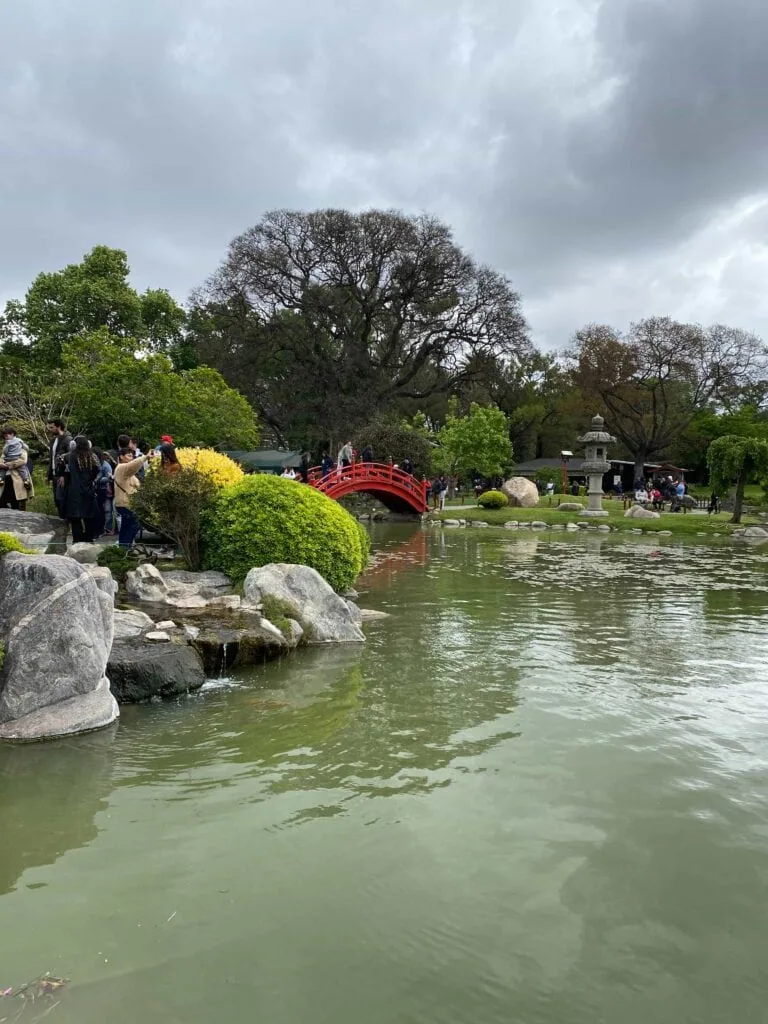
Day 3: See One of the World's Most Beautiful Cemeteries and a Tango Show
For your last full day in Buenos Aires, I always recommend keeping some time open to hit any other tourist attractions on your list. Some to consider include:
- Visiting more parks like Ecoparque Buenos Aires, Tres de Febrero, and Jardín Japonés (Japanese Garden)
- Going on a walking tour
- Checking out the El Ateneo Grand Splendid bookstore in a former theater and Teatro Colón, one of the best theaters in the world
Afterwards, you'll spend time seeing a couple attractions in the city that you can't miss!
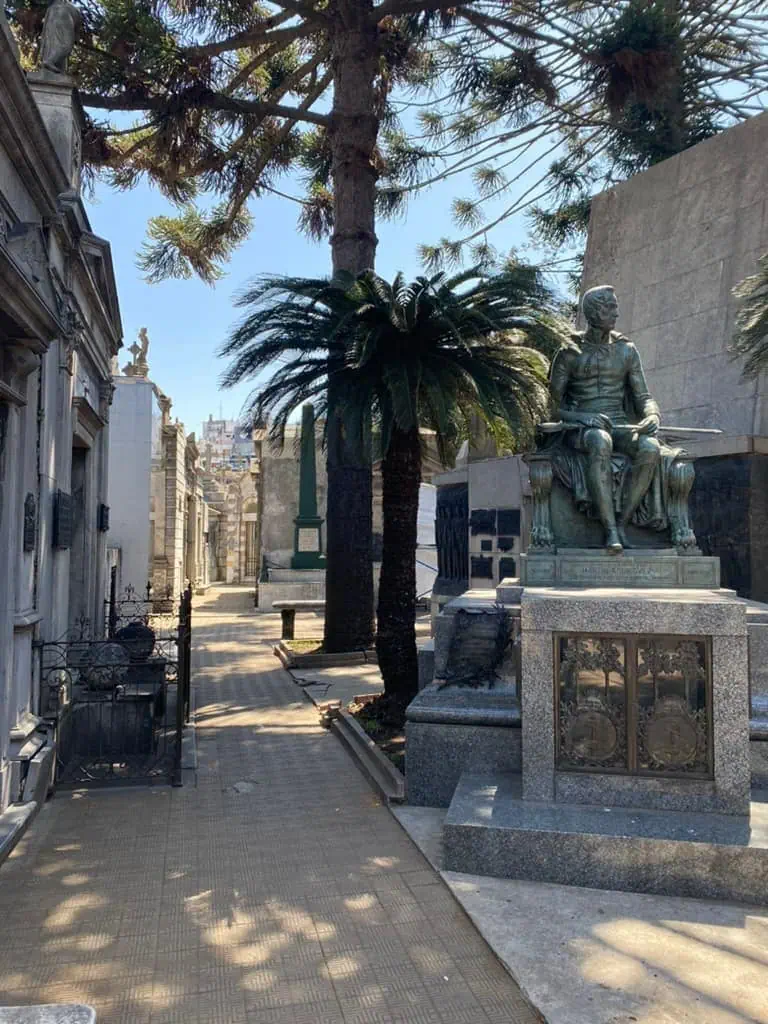
Take a Guided Tour of Recoleta Cemetery
In the afternoon, head over to Recoleta to visit what's arguably the city's #1 tourist attraction: Recoleta Cemetery.
I know what you're thinking: ummmmm… did I just read cemetery?!
Yep! It's a bit shocking I know, but this cemetery is considered one of the most beautiful in the world. Plus you can see the burial sites for Eva Perón, Argentine presidents, military leaders, and more.
I just walked around the cemetery on my own, but I really wish I had done a guided tour because it was hard to navigate the cemetery and figure out the stories behind everything by myself.
This low-cost tour in English is on my list for my next visit!
I highly recommend booking this tour so you can get more out of your visit to the city's arguably #1 tourist attraction.
➡️ Book Your Recoleta Cemetery Tour Here
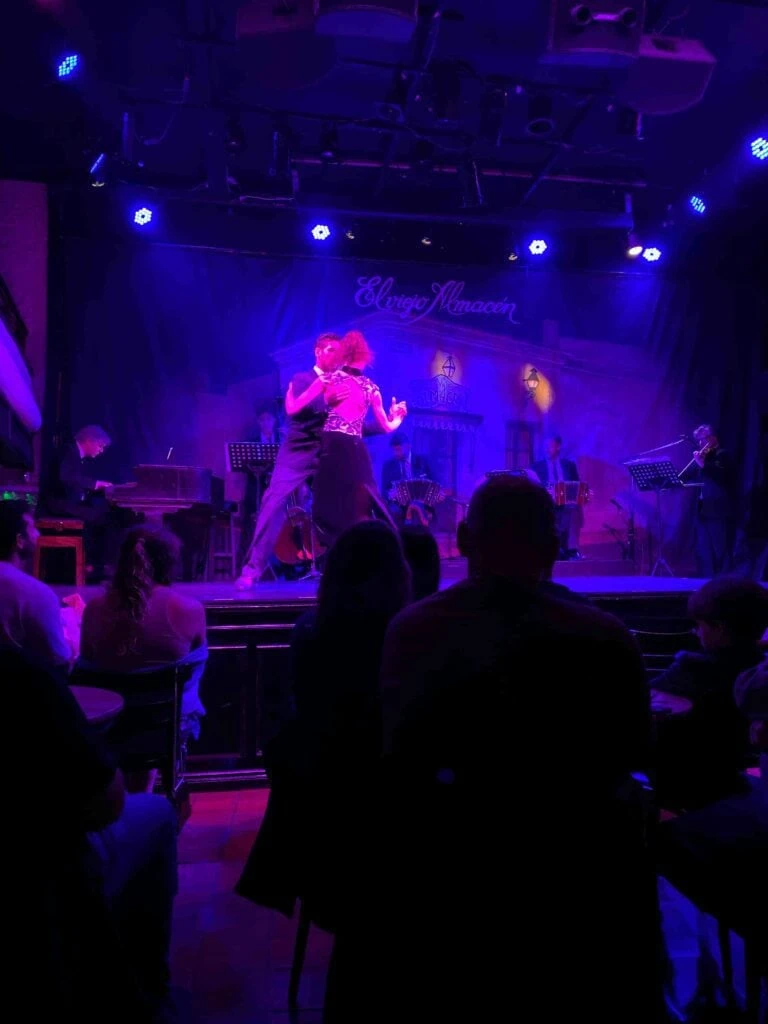
See a Tango Show Where it All Began
To wrap up your time in the city, attend one of its many tango shows. No visit to Buenos Aires is complete without seeing a show. The music and dance style originated there after all.
I saw a show at El Viejo Almacén and really enjoyed it. When I was researching shows, it seemed like one of the more affordable and most traditional and authentic options.
This tango show is one of the best in the city. Along with your show ticket, I also recommend booking dinner so you don't have to fret about the logistics of that before or after the performance.
➡️ Book El Viejo Almacén Here
➡️ Read my Full Review of El Viejo Almacén Here
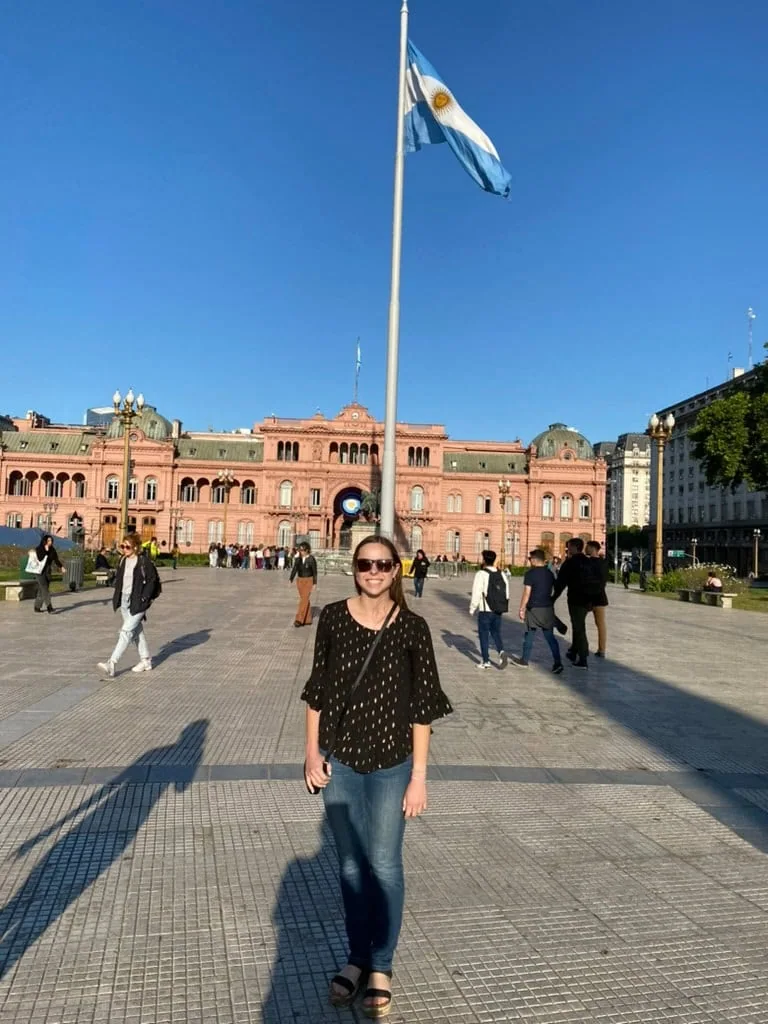
Food/Drink Recommendations in the City
- Asado experience for meat
- Mate tasting for the popular tea
- Moshu Treehouse for brunch
- Don Julio for steak at the 10th best restaurant in the world
- Tigre Morado for Peruvian food
- Fábrica del Taco for Mexican food
For more recommendations on food/drinks and things to do in the city, check out my other Buenos Aires articles here.
Where to Stay in Buenos Aires
📍Budget Option: You can book either private or shared rooms at Casa Vaca in Palermo Soho. It's really well reviewed with guests saying staff are friendly and the space is clean.
📍Mid-Range Option: Legado Mítico is a boutique hotel in Palermo Soho. It's highly rated, and I would love to check it out next time!
📍Luxury Option: Treat yourself to a stay at Palacio Duhau, a historic mansion, where you'll feel like royalty!

Days 4-6: Mendoza
For your next stop, visit Argentina's premier wine region Mendoza. It's the perfect place to relax and enjoy some excellent food and wine for several days. It's an absolute must visit for any wine lover!
Day 4: Fly to Mendoza and Visit Your First Winery
Buenos Aires typically has loads of flights to Mendoza every day. I recommend flying out sometime in the morning so you can maximize your time in Mendoza, starting off with a fabulous winery lunch.
The day I got in, a driver picked my dad and I up from the airport, brought us to our hotel for check in, and then took us to lunch at Trapiche.
This iconic winery is one of the larger ones in the region–so large, in fact, that I've even found their wine in my local grocery store in North Carolina in the U.S. The winery was founded in 1883, making it one of the oldest in Argentina.
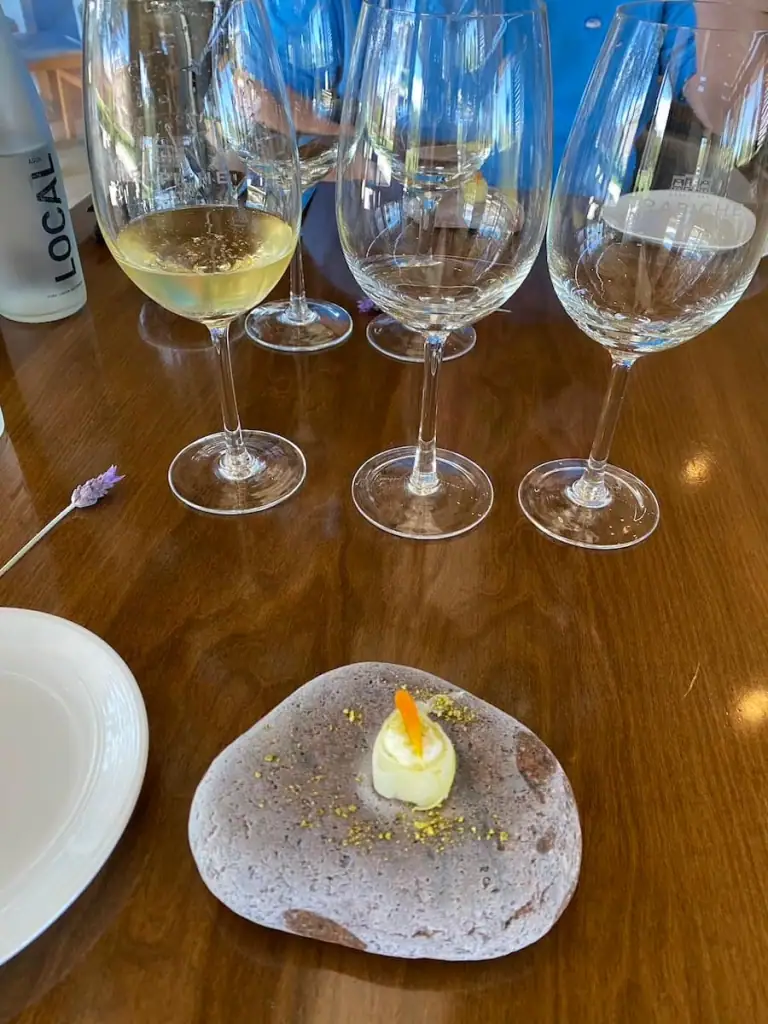
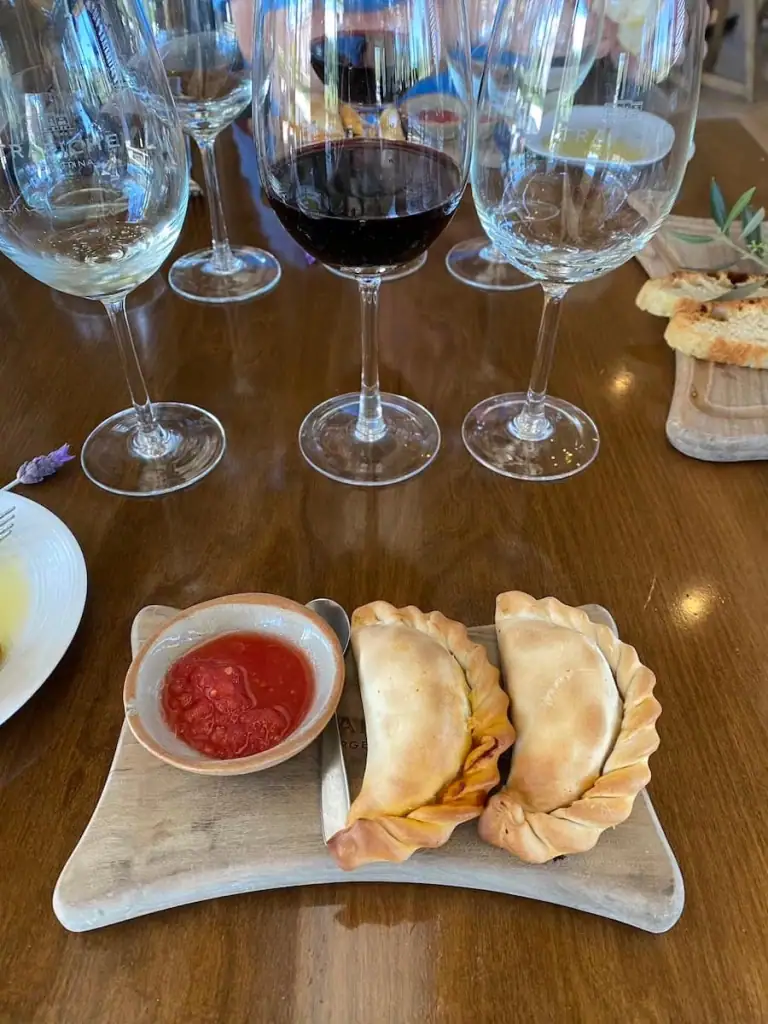

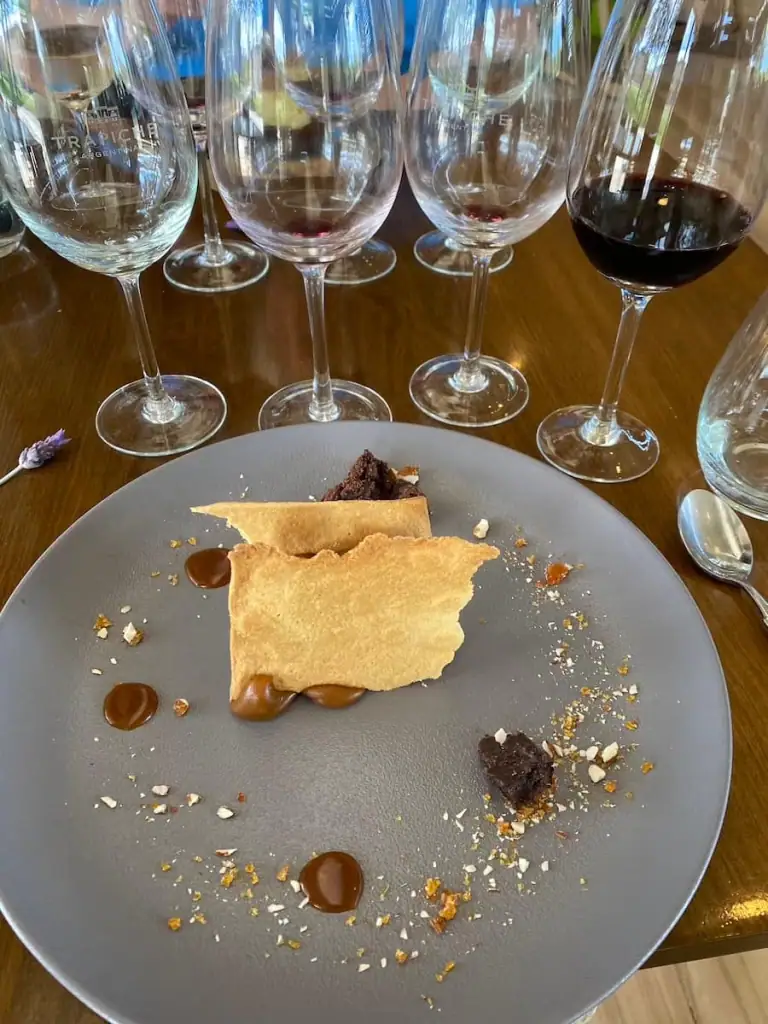
We enjoyed a lovely multi-course meal with a wine pairing at Trapiche's restaurant, which is recognized by the Michelin Guide. We had:
- Some kind of palate cleanser to start
- Empanadas
- Steak (my dad) and pork (me) for the main course
- Another palate cleanser
- Dulce de leche dessert
It was an absolutely lovely meal, and a great way to start off our time in this wine region. Plus, I found it quite affordable.
At least when we visited in October 2022, we paid around $50 each. I've never been to Napa Valley in the U.S., but I imagine a similar experience there costs at least double or triple…
Your hotel might be able to organize an airport transfer and winery visits for you, but if not, you can book here.
➡️ Book Your Mendoza Airport Transfer Here
➡️ Book Your Winery Driver Here
➡️ Make a Lunch Reservation at Trapiche Here
After lunch, spend some time relaxing in your hotel. There are so many hotels in the Mendoza region that are so lovely, you'll want to ensure you have some time to really enjoy them.

Day 5: Take in the Natural Landscape and Relax
You might be feeling a little stuffed at this point in your trip from all the amazing food and drinks you've been having. But don't worry–Mendoza has tourist activities beyond just eating and drinking!
For day 5, you'll take a bit of a break from all that and instead focus on enjoying your beautiful surroundings.

Go Horseback Riding
Situated at the foot of the Andes with views of the tallest mountain in the Americas, Mendoza has spectacular scenery. For a unique experience that allows you to enjoy these spectacular views, go horseback riding.
Horseback riding not your thing? Consider this mountain tour instead.
During the experience, bilingual guides will take you on a 1.5-hour horseback ride that includes a visit to a lookout point with sweeping views of the Andes Mountains.
I recommend booking the morning tour and opting out of the asado lunch since you'll likely need a break from all the heavy meals. However, if you're feeling up for it, the sunset horseback riding experience with asado dinner and bonfire does sound pretty cool.
Enjoy the mountain views in the Mendoza region with this highly-rated horseback riding experience that includes transportation.
➡️ Book Your Horseback Riding Experience Here

Relax in Your Hotel Pool or Spa
When I think of Mendoza, I think relaxation. To me, Mendoza is all about enjoying great wine and food while giving your body time to relax, especially after walking around a big city for days and before you start hiking in Patagonia.
With that in mind, spend the rest of the day with some quiet “me time” at your hotel pool or spa.
I personally had a wine bath at my hotel. It was such a cool and unique experience! I'm not one to visit spas very often, but I really felt so relaxed after that.
Unfortunately, that hotel has since been purchased by another hotel and is under new management, so I can't speak to what they're doing now. But many hotels in the region have nice spas or at least a pool.

Day 6: Visit Wineries Around the Region
No visit to Mendoza would be complete without a full day winery tour. As Argentina's largest producer of wine, the Mendoza region has over 1,000 wineries.
It might feel a little overwhelming trying to decide where to visit, but I'm sure you really can't go wrong! I would talk to your hotel for advice or book a prearranged tour like this.
My hotel helped us decide on wineries for our visit, and ultimately we chose the following:

Bodega Bressia for a tour and tasting: This is a small family run winery. I really liked their Lágrima Canela, a white wine that they said is made for people who like red wine, and their Profundo, their first-ever wine that's a blend of 50% malbec with some other reds.
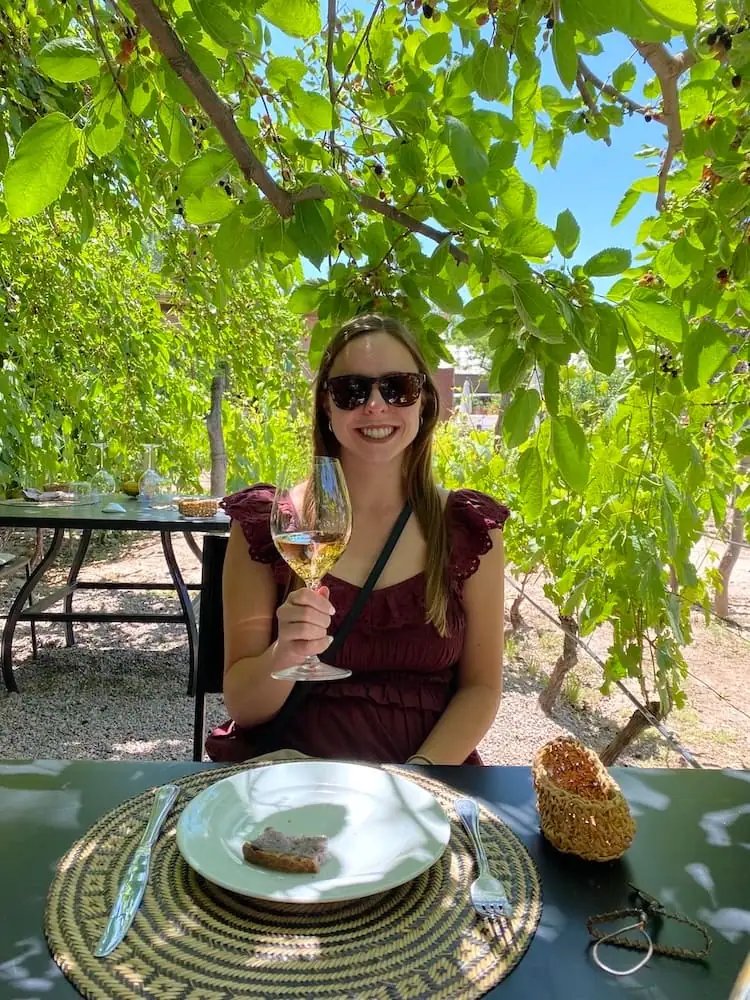
Bodega Lagarde for a tour and lunch: I knew I had to visit this winery after a friend raved about it. This family-owned winery started in 1897 and is now run by two sisters who are the third generation in their family to do so. My favorites wines were the Malbec DOC and the Henry, which is their special red wine that they mix by hand.
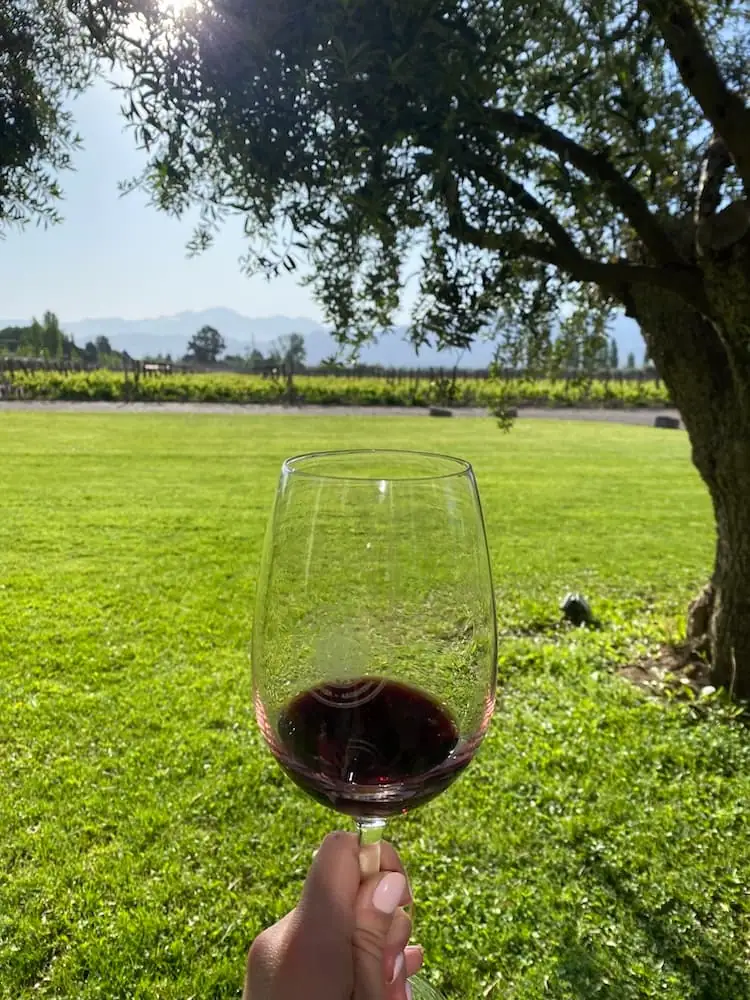
Bodega Vistalba for a tour and tasting: This is a small winery with spectacular views where they interestingly make all their wines using gravity and without pumps. My favorite wines were their sauvignon blanc, malbec, and syrah.
Your hotel may be able to organize winery visits for you, but if not, this is a highly rated tour you can book that includes visits to three wineries.
➡️ Book Your Full Day Wine Tour Here
If you want to visit specific wineries, you can make the reservations on your own and book a driver.
➡️ Book Your Winery Driver Here

Food/Drink Recommendations in the Area
- Bodega Trapiche for a winery lunch or tasting
- Bodega Lagarde for a winery lunch or tasting
- Michelin Star Restaurants
Where to Stay in Mendoza
📍Budget Option: Guests rave about Gorilla Hostel‘s nice spaces and communal events like film nights, walking tours, culture classes, and more. The hostel has a pool, garden, bar, and outdoor game room.
📍Mid-Range Option: Heura Petit Hotel is one of the highest rated hotels in the area. The hotel has a pool, garden, and sun terrace. In addition, the hotel provides bicycles, yoga classes, and more.
📍Luxury Option: Entre Cielos Luxury Wine Hotel & Spa is considered by many to be the top luxury hotel in the Mendoza area and even in all of Argentina. The hotel has its own winery, restaurant, spa, and pool onsite.
Note that Heura Petit Hotel and Entre Cielos are not located in Mendoza's city center. In my opinion, many of the best places to stay are outside of the city. However, you may need to double check with tour providers before booking to ensure they can pick up from outside of the city center.

Days 7-8: El Calafate
One week into your trip, it's now time to transition to one of the most beautiful parts of Argentina: Patagonia.
Day 7: Fly to El Calafate
Brace yourself because this is going to be a long travel day, but that's the nature of traveling around Argentina.
From Mendoza, you'll need to book a one-way flight to El Calafate. Flights between the cities will have a layover likely in Buenos Aires or Córdoba. Total travel time can last anywhere from 6 to 10+ hours.
Flights are limited, so I highly recommend booking early so you can find the best flight possible:

Day 8: Visit Perito Moreno Glacier on a Hike
For your first full day in El Calafate, you have to go on a tour to the Perito Moreno Glacier, one of the top attractions in all of Argentina.
Located in Argentina's Glaciares National Park, a UNESCO World Heritage Site, the 19-mile long Perito Moreno Glacier is considered one of the best glaciers to see in the world.
The glacier sits on top of the massive Lago Argentino lake and is surrounded by snow-capped mountain peaks. From both the lake and viewpoints nearby, you can get excellent views of the glacier's towering walls and see just how expansive it is.

The best way to really make the most of your visit to the glacier is on this glacier hike. The full day experience includes:
- Transportation to and from the park, with a bilingual guide that shares information in English and Spanish on the glacier during the drive
- A boat ride on Lago Argentino
- Hiking on the glacier, including visiting any ice caves if you're lucky
- A visit to viewpoints above the glacier
The hike is not very challenging, and you don't need any mountaineering or ice hiking experience to do it. The guides will give you all the equipment you need to stay safe and will lead you through stable areas of the ice.
I did this exact tour and highly recommend it. It's definitely pricey, but I think it's absolutely worth it for giving you such a unique once-in-a-lifetime kind of experience.
What better way to visit a glacier than by seeing it from all sides? On this tour, you get to see Perito Moreno from a viewpoint above, from a boat on the water below, and even from on top of it while hiking.
➡️ Book Your Glacier Hike Here
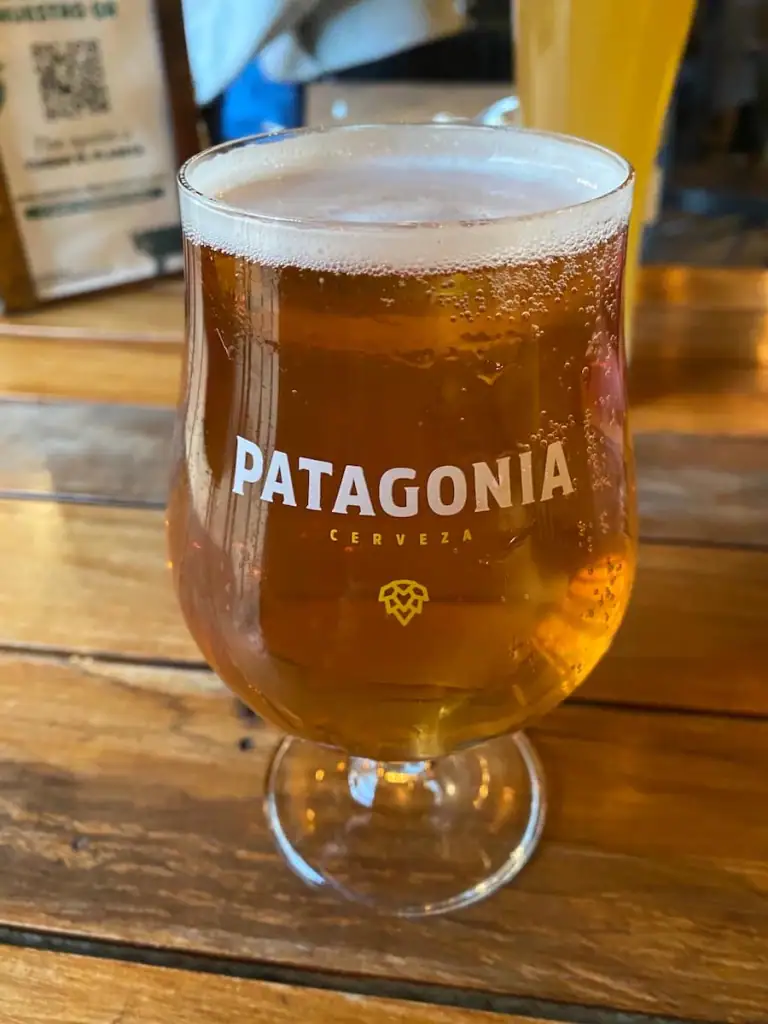
Food/Drink Recommendations in the Area
- Mi Rancho Restaurant Patagónico for traditional food
- Patagonia Brewing for craft beer and food
- Pantagonia for sandwiches and baked goods
Where to Stay in El Calafate
📍Budget Option: Folk Hostel has both shared and private rooms at reasonable prices. Guests can also enjoy the hostel's outdoor patio, kitchen, and lounge area.
📍Mid-Range Option: MadreTierra Patagonia is centrally located in the middle of town. I stayed here and found staff to be very kind and helpful. We even got a complementary ride to the bus station from one of the staff members.
📍Luxury Option: One of the nicest hotels in El Calafate, Hotel Posada Los Alamos has a spa, indoor pool, and views of the mountains and a garden.

Days 9-10: El Chaltén
El Chaltén sits just 133 miles (214 km) from El Calafate and has arguably the best hiking in Argentina. It's a quiet little town without much going on, but if you're a hiker, it's a must-visit for any trip to Argentina.
Logistically it's a pretty easy place to visit too because you can get around without a car. Just hop on a bus from El Calafate to get to El Chaltén. And once you're in town, you can reach all the most popular hiking trails on foot.

Day 9: Bus to El Chaltén and Hike to Laguna Torre
Book a morning bus out of El Calafate, usually around 8 a.m., and you should arrive in El Chaltén in about 2.5-3 hours.
If you're feeling up for it and weather looks good, I recommend doing all or a portion of the Laguna Torre hike.
Hike to Laguna Torre
The Laguna Torre hike is overlooked by some hikers visiting El Chaltén, but this actually turned out to be my favorite of the two hikes I did here (although both were epic!).
While this is a fairly challenging hike, it is easier than the more popular Mount Fitz Roy hike.
At the start of the trail, there are some steep sections as you climb up out of town and into the mountains. You get great views of the town below until it disappears as you get farther into the wilderness.
Even from the very beginning, you're rewarded with epic views of mountains all around you. At one point you can see a waterfall in the distance.
TIP: If you're looking for easier hikes in El Chaltén, here are a few other options:
- Laguna Capri (can be part of the Mount Fitz Roy hike) – 5.9 miles (9.5 km)
- Chorillo del Salto – 4.1 miles (6.6 km)
- Cerro Torre Viewpoint (part of the Laguna Torre hike) – 3.7 miles (6.0 km)
- Condor Lookout – 1.6 miles (2.6 km)
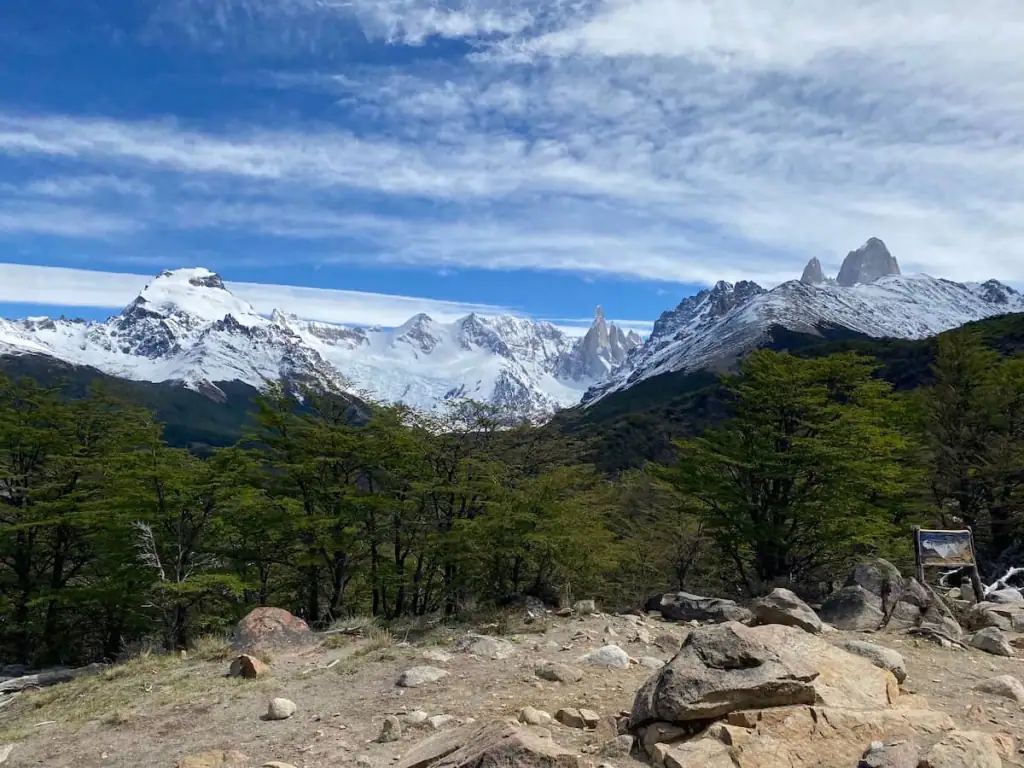
At about 1.6 miles (2.5 km) from the trailhead, you'll reach a lookout that offers incredible views of the iconic Fitz Roy and Cerro Torre mountain peaks. This is a good point to turnaround if you don't want to do the whole hike.
After the lookout, you'll descend down into a mountain valley where you'll hike for a bit. This might have been my favorite part of the hike. It just felt so epic walking forward towards the Cerro Torre mountain looming in the distance.

Note there is a small risk of a glacial outburst flood in this valley due to an active landslide by Laguna Torre. You'll see signs about this before you descend. Just stay aware of your surroundings and if you see water levels rapidly rising all of a sudden, head to higher ground immediately.
After around 5.5 miles (8.9 km), you'll finally reach Laguna Torre, a milky blue glacial lake at the base of Cerro Torre.
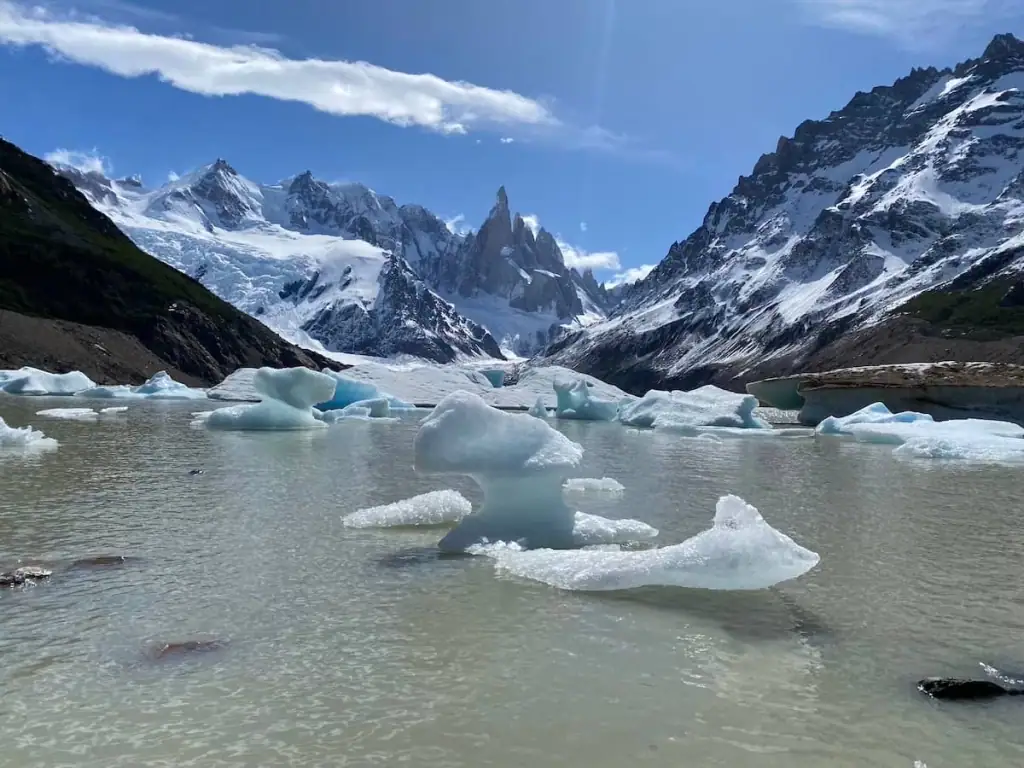
This approximately 11-mile (17.7 km) hike took me about 4.5 hours in total, but I didn't stop much on the way, didn't hike all the way alongside the lake, and did hike fairly quickly. It seems like a lot of folks do it in around 6 hours.
Depending on your walking speed, it might be a bit too much to fit the whole hike in since you'll be getting a late start. Since it's an out and back, you can turn around at any point to safely return to town before the sun sets.

Day 10: Hike to Argentine Patagonia's Most Famous Mountain
For your full day in El Chaltén, you have to do what's arguably Argentina's most iconic hike and the top thing to do in the area: hiking to the base of Mount Fitz Roy, also referred to as the Laguna de Los Tres hike.
This is a challenging hike, but it offers great views all along the way, so if you're not up for more of a challenge, feel free to just hike a portion of it.
Fun fact: Mount Fitz Roy is the mountain featured in the Patagonia clothing company logo!
Hike to the Laguna de Los Tres and Mount Fitz Roy
Like the Laguna Torre hike, this one starts right on the edge of town. At the start, you hike up into the mountains until you lose sight of El Chaltén.

At about 2.5 miles (4 km) in, you reach a lookout with excellent views of Mount Fitz Roy. From there you pop in and out of forests and continue on in a valley alongside a river for much of the way.
Much of the hike is only moderately challenging until you reach about the last mile (1.6 km) before the end point of the trail. This last mile is so steep and rocky that it generally takes about one hour.
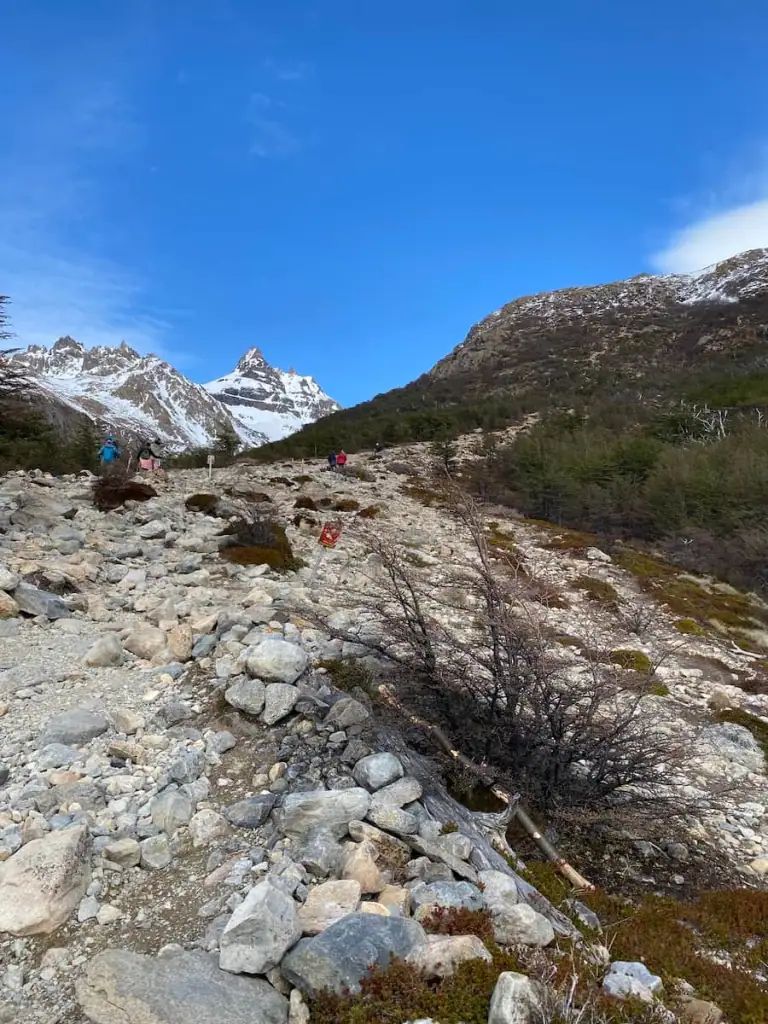
While this last bit of the trail is super difficult, it's rewarding with great views at the top. While kind of cool, I did think it was a bit of a shame that our view was obscured by snow. There's quite a beautiful lake at the top, but we couldn't see it.
However, the rest of the views were incredible, and it was cool to see snow blowing off the mountain tops above.
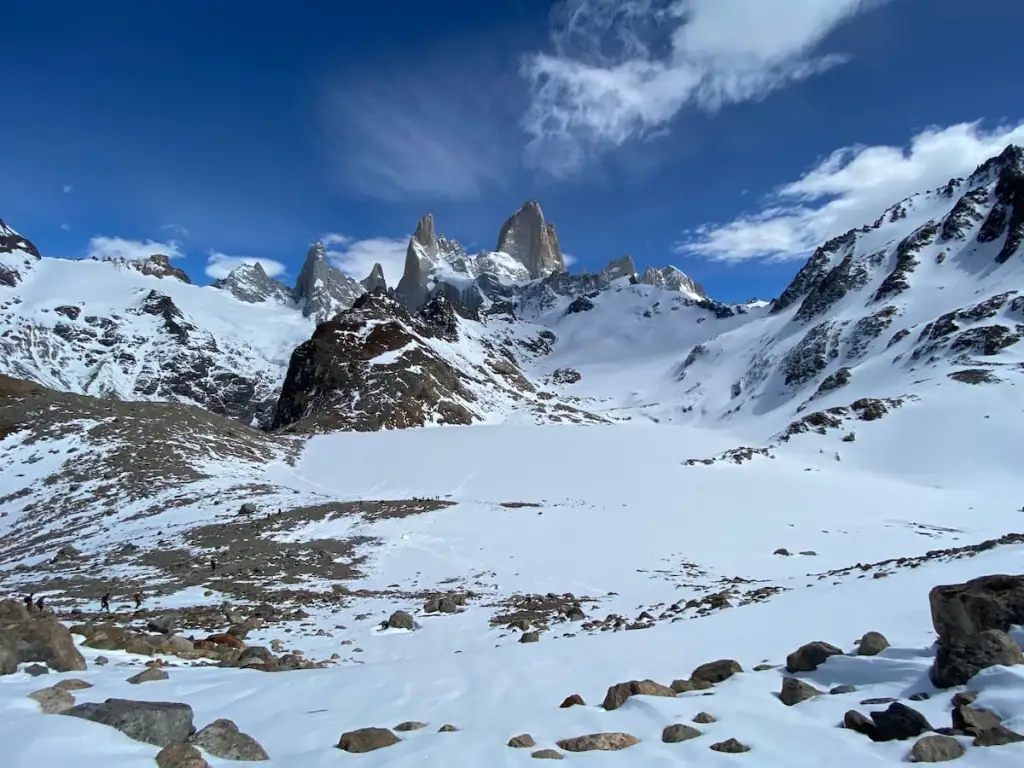
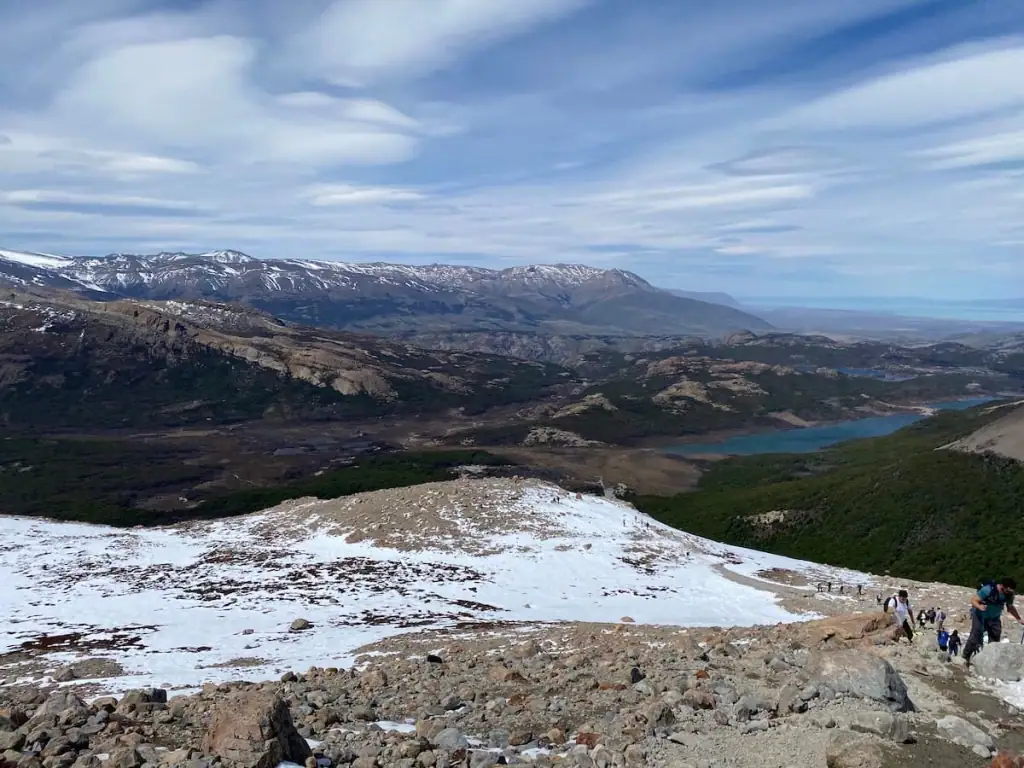
This trail is an out-and-back, so you return the same way. However, you can change it up slightly by walking by the Laguna Capri lake on the way back.
By the time we got back to town, I was absolutely exhausted. My Garmin recorded 3,302 feet (1,006 m) of elevation gain and about 7.25 hours in total on the hike.
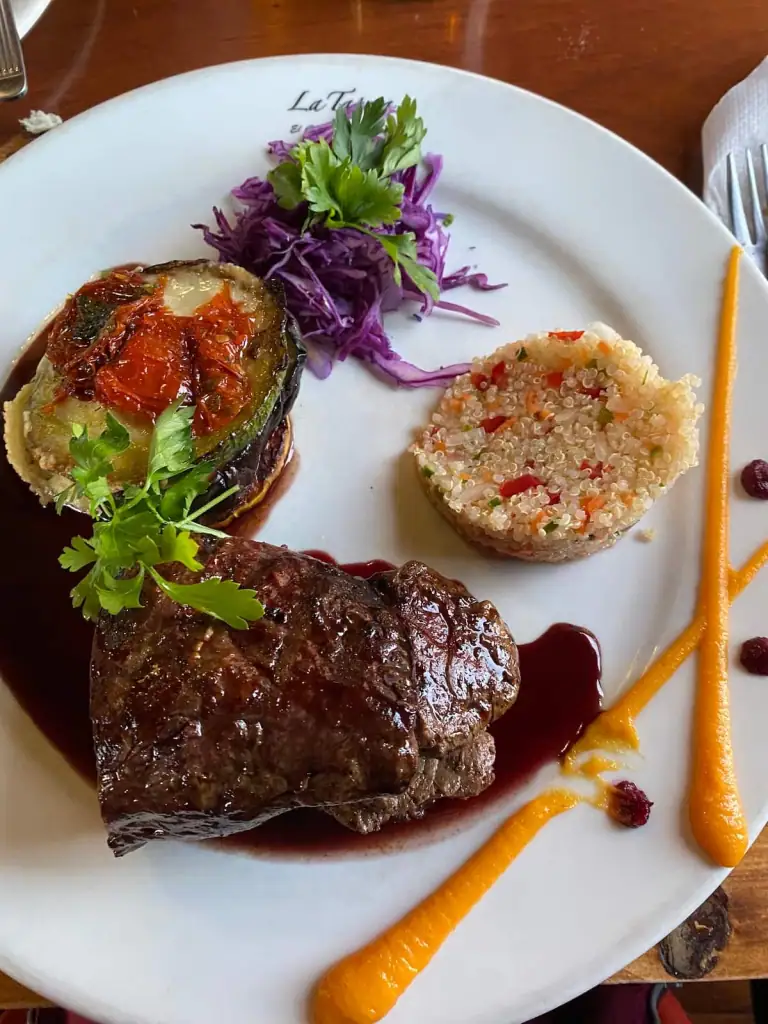
Food/Drink Recommendations in the Area
- La Tapera for arguably the best meals in the town
- Maffia for Italian food
- The Asadores for a multi-course asado
- Panadería y Confitería los Salteños for empanadas
Where to Stay in El Chaltén
📍Budget Option: Hostel Luna Country is a one of the highest rated hostels in town. The hostel has the option to either book a shared or a private room.
📍Mid-Range Option: I stayed at Posada y Cabañas El Barranco in one of their bungalows and loved the private space. The hotel has a great location too as it’s fairly close to the main trailheads for some of the top hikes in the area.
📍Luxury Option: One of the nicest hotels in town, Los Cerros del Chaltén Boutique Hotel is said to have great views and helpful staff who go above and beyond for guests. The hotel can help book tours and activities, and it has its own spa and restaurant onsite.
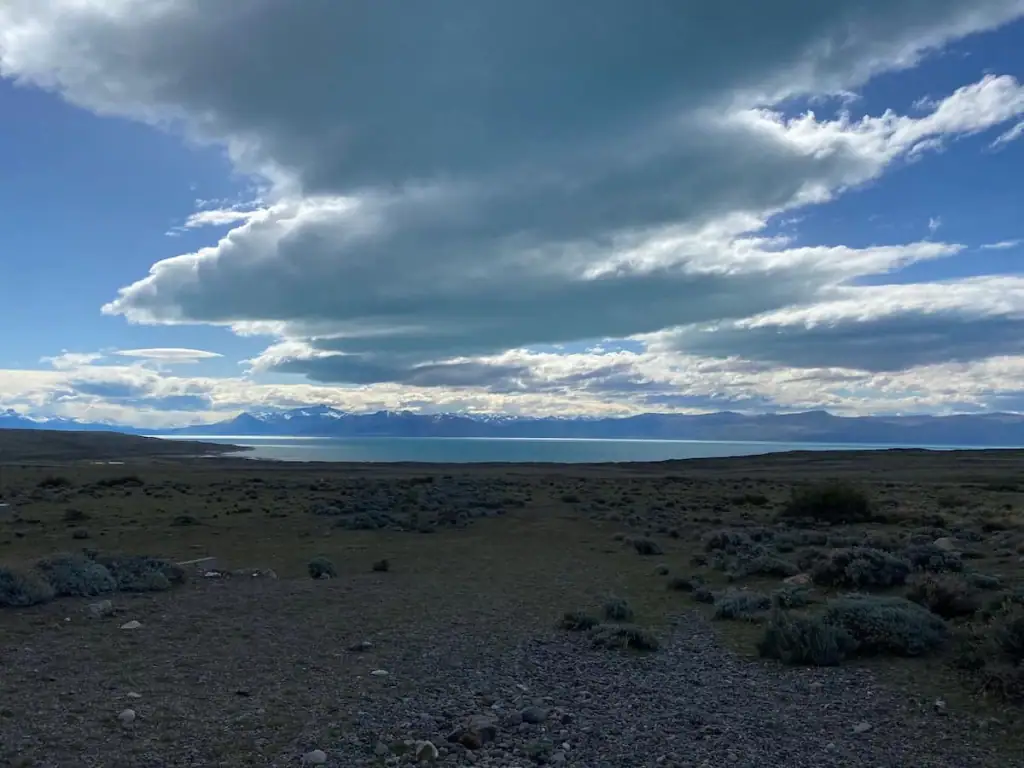
Day 11: El Calafate
Day 11 will mostly be another travel day back to El Calafate. El Chaltén is so small that you pretty much have to go back to El Calafate unless you're doing a big road trip and driving between all your destinations.
Day 11: Bus Back to El Calafate + Learn More About Glaciers
Just as I traveled on the way out, I returned back to El Calafate by bus. I found the bus ride pretty comfortable, and it made traveling around really easy.
Go for a Walk to See Some Flamingos
If weather is nice when you get back to El Calafate and you want to stretch your feet a bit after the bus ride, take a stroll around the Reserva Laguna Nimez nature preserve or walk alongside the lake.
I walked to this mirador (lookout point) alongside the lake. If you're lucky, you might see some flamingos and other wildlife!

Visit the Glaciarium Museum of Ice
There's not much to do in El Calafate proper, but one of the top things to do is visit the Glaciarium Museum of Ice. It's a great way to finish your last day in the city and in Argentine Patagonia.
This museum has exhibits to covering how glaciers form and change over time, the Perito Moreno Glacier specifically, and other notable glaciers throughout the world.
The museum is located just outside of El Calafate. It's not walkable from the city center, but they have free shuttle transfers every day from 12 p.m. to 5 p.m.
The shuttle typically leaves El Calafate from here at the top of the hour and then leaves the museum at the half hour. If you plan to take the shuttle, it's a good idea to arrive a bit early.
As of writing this, entrance to the museum costs 25,000 pesos (about $17 USD). Pricing in Argentina can change frequently, so keep in mind that this might change slightly.
I felt this price was worth it. Even after taking the Perito Moreno tour, I still learned quite a bit on my visit to this museum. In particular, I found it fascinating to see a film about when an arch formed on the edge of the Perito Moreno Glacier and then eventually collapsed.

Days 12-15: Torres del Paine National Park, Chile
For some more epic hiking in Patagonia, it's worth crossing the border into Chile to wrap up your trip.
Torres del Paine National Park is home to some of the absolute best hikes in Patagonia that you won't want to miss if you aren't planning any future trips to the region. Plus, it isn't too hard to reach from El Calafate.
Note: Torres del Paine is known for its amazing multi-day hikes called the W-Trek and the O-Trek. I just did day hikes but highly recommend the multi-day hikes if you have more time. If you don't have time on this trip and plan to visit Chile another time for those hikes, then you might swap this out for Iguazú Falls instead.
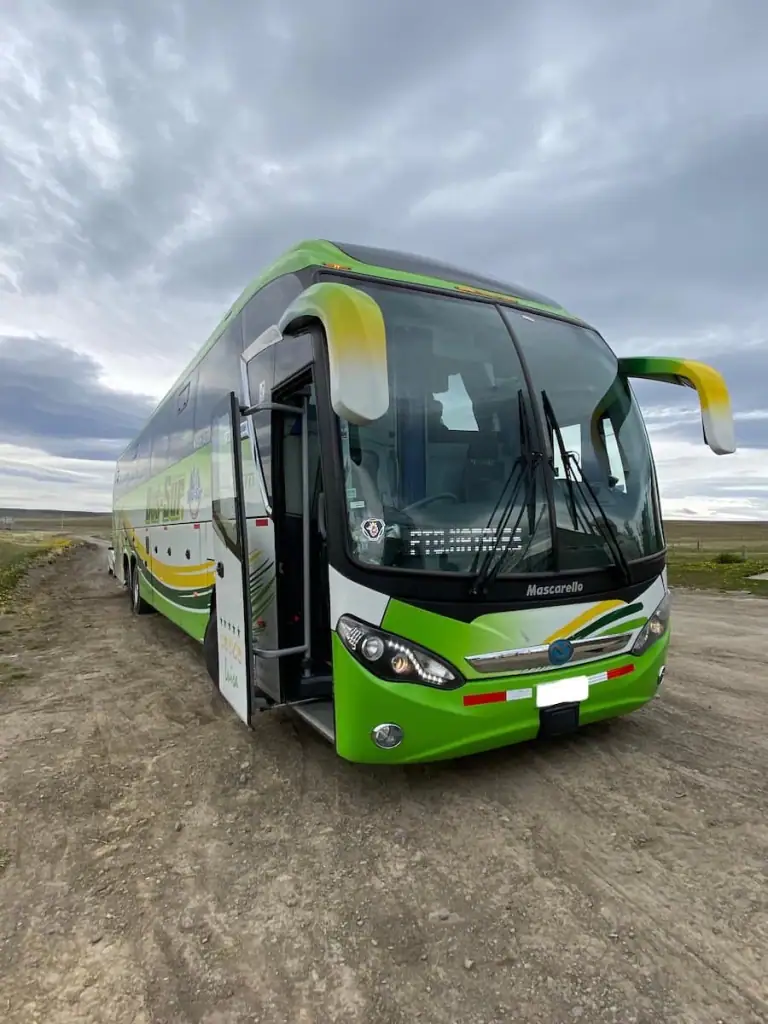
Day 12: Bus to Puerto Natales and Drive to Torres del Paine National Park
The easiest way to get from El Calafate down to Torres del Paine National Park is by taking a bus down to Puerto Natales and then a rental car from there to your accommodation in or near the park.
Bus South to Chile
It's about a 5-hour bus ride down to Puerto Natales. While it's a bit long, I found the bus to be pretty comfortable. They did make at least one stop for a bathroom break from what I remember.
The nice thing about traveling by bus is that they help you navigate the border crossing. I've never done a border crossing on land like this before, so it was nice to have the extra support that we wouldn't have had if we had driven on our own.

Rent a Car from Puerto Natales
When you arrive in Puerto Natales, it's an easy walk from the bus station down into the main part of the city where you'll want to pick up a rental car.
Note that rental car companies have very limited hours here. The way I put together my itinerary, we would be returning the car on a Sunday, but some of the rental car companies weren't even open on Sundays. The one we used was open then but closed much earlier than I had wanted for returning the car.

Once you have your car and are ready to hit the road, it's about a 2-hour drive towards most accommodations around the park.
Depending on your route, the road may not be fully paved in some areas. As a driver, I didn't find it particularly fun, but at least there were some good lookout points with awesome views along the way.

Day 13: Hike Chilean Patagonia's Most Iconic Trail
For your first full day, plan to hike to the Mirador las Torres, the park's most popular hike that takes you to the base of its iconic Torres (meaning towers).
This is a highly challenging but incredible hike that's also part of the multi-day W-Trek. My watch recorded about 13.5 miles (21.7 km) with 3,576 feet (1,090 m) of elevation gain. It took us almost 7 hours to complete.
Hike to the Mirador las Torres
For this hike, you'll park at the visitor center near Hotel Las Torres. If you're staying at that hotel, you don't even have to drive–lucky you!
Not long into the hike, you'll start hiking up a fairly steep section. Thankfully the trail mellows out for a while and is fairly flat after that initial ascent.

Around halfway to the towers you'll reach Refugio El Chileno, one of the many mountain huts in the park. Here you can refill your water bottle if needed and pay in cash to use a flush toilet. You can even buy drinks and snacks here too.

As you continue onwards, you'll pop into the forest for a little while. Elevation will gradually increase but won't be too bad until around the last mile (1.6 km).
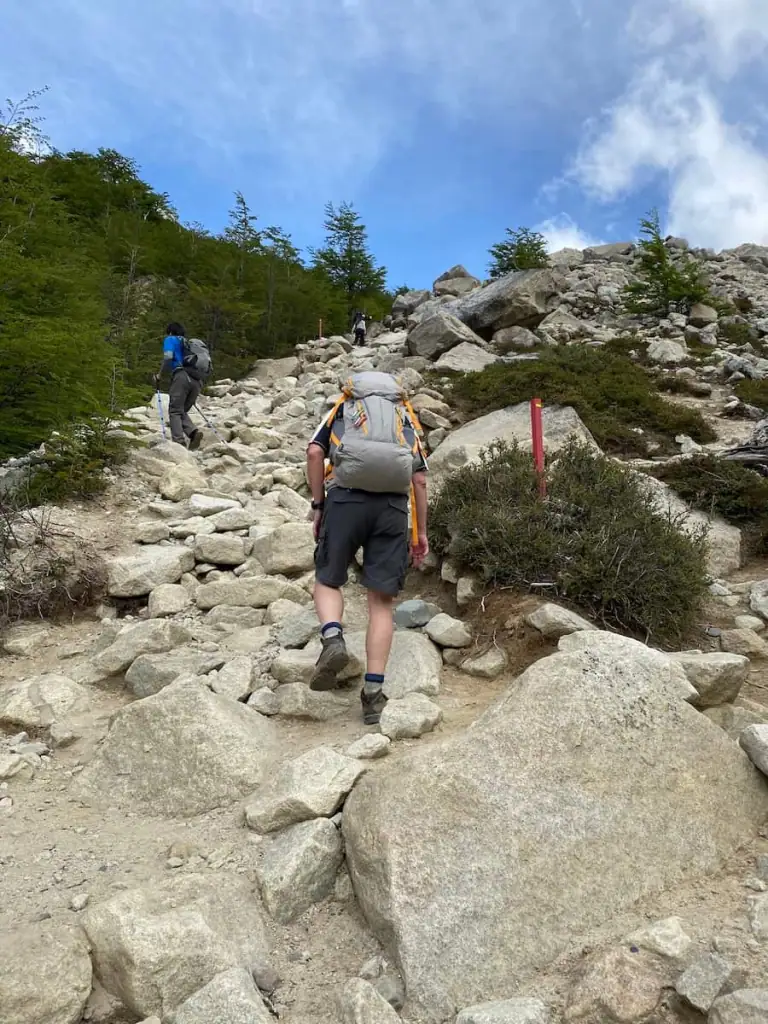
Like Mount Fitz Roy, the last mile of this hike is an absolute slog and takes about an hour. Unlike Fitz Roy, I found this one a bit more challenging with larger rocks to navigate.
But by the time you make it to the top, it's totally worth it! We really enjoyed lounging around taking in the sight of the granite towers and the milky blue lake.

This hike is an out and back, so you return the same way you came. On your hike back, I encourage you to take a break at the refugio and then once you've reached the visitor's center.
When we stopped at the visitor's center, I was able to buy a Gatorade and a snack. It was nice to be able to sit and recover for a bit before the long drive back to my hotel.

Day 14: Hike Another Part of the W-Trek
The famous W-Trek can be done in day hikes. It was our plan to do three day hikes to cover it, but we ended up only getting to do two because of our rental car drop-off time.
In the end, we were pretty exhausted, so I don't know how much we would have enjoyed another intense day of hiking anyways.
For our final hike of the trip, I was torn between the Grey Glacier hike and the French Valley hike. Both start from the same place.
We ultimately chose the French Valley hike because we figured we already saw an incredible glacier and this hike might offer something a bit different.
Hike the French Valley
The French Valley hike is a bit more logistically complicated to reach than the Torres hike. You'll need to park here and then take a ferry across the Lago Pehoé lake.

The boat trip across the lake to Refugio Paine Grande typically takes about 30 minutes, but it can take much longer if it's busy. You'll definitely want to take the first ferry out in the morning for your hike. You can check here for the latest ferry timetables and pricing.
In my experience, the morning ferry wasn't very busy, and we didn't have any delays. It was an awesome way to see more of the park, especially the famous Cuernos (meaning horns).

Much of the French Valley hike isn't too difficult. It's relatively flat until you get to the last mile-and-a-half of the trail when you then have to hike up over 1,000 feet (305 m) to reach the Mirador Francés lookout.
Some people go farther to the Mirador Británico lookout, but we were too tired to do that, and I don't think we would have had the time since we had to catch the ferry back.
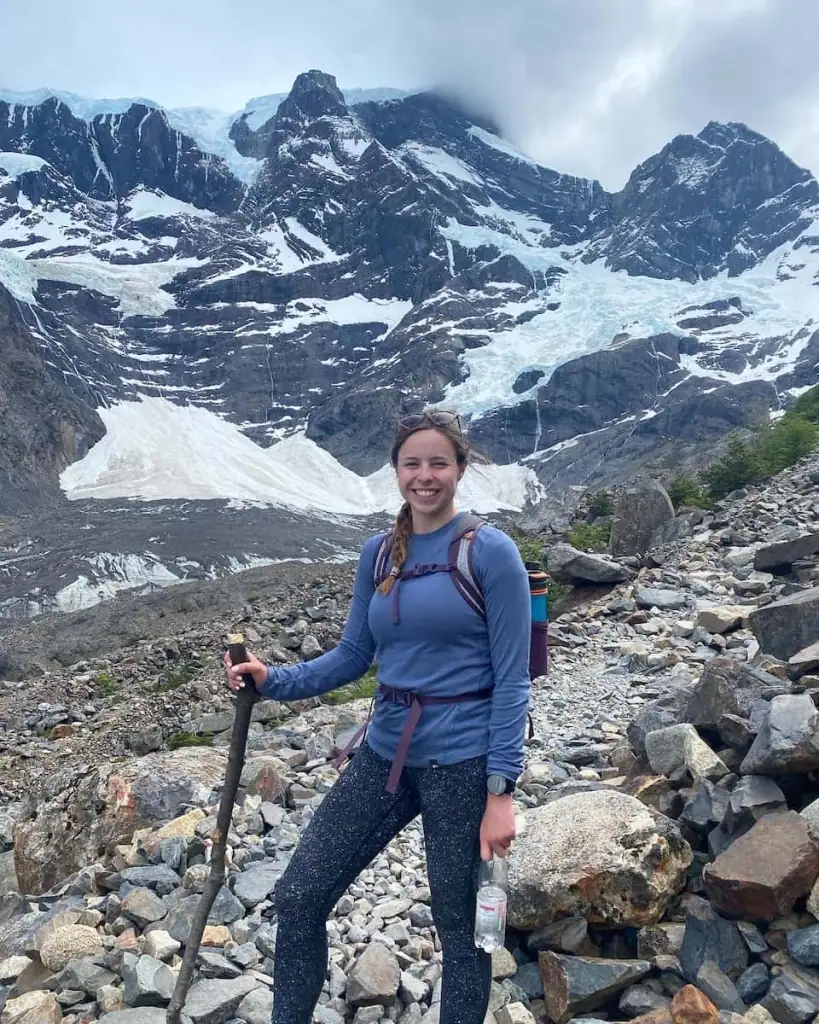
From the lookout point, you get cool views of a nearby glacier. That said, the views weren't as spectacular as the Torres or Mount Fitz Roy hikes.
I think if you wanted to do a more lowkey hike on this day, you could still consider this one but skip the last section. There are lovely views of the mountains and lakes all throughout the rest of the hike.
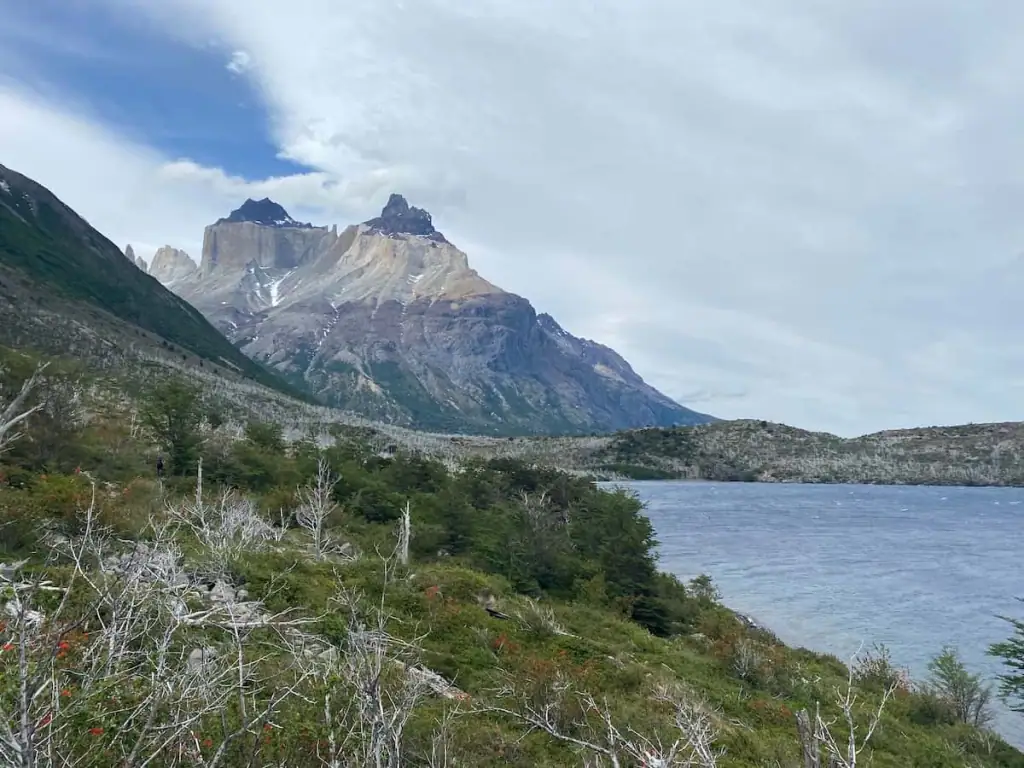
By the time we made it back to Refugio Paine Grande to wait for the ferry, we were absolutely beat. My watch recorded about 6.5 hours, 13.15 miles (21.2 km), and 2,233 feet (681 m) of elevation gain.
The ferry back was much more popular. There was a line to get on, and it took around an hour or so to load. Unloading took quite a while as well, so we definitely finished much later than we had anticipated.
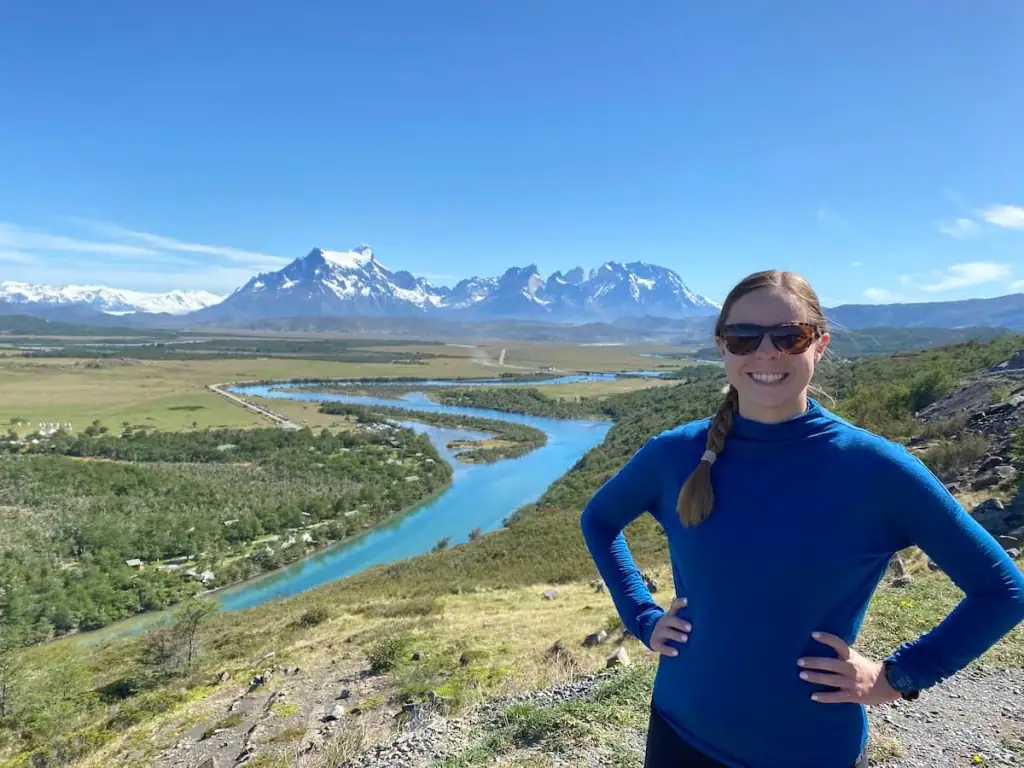
Day 15: Drive Back to Puerto Natales for the Night
For your final day of your trip, you might spend a bit of time driving around the park and enjoying the views before heading back to Puerto Natales to return your rental car.
If you have the energy, you might consider doing a short hike like:
- Mirador Cuernos – 3.9 miles (6.3 km)
- Mirador Lago Grey – 2.9 miles (4.7 km)
- Mirador Salto Grande – 0.9 miles (1.4 km)
Once you return to Puerto Natales, know that there isn't loads to do there. However, you could spend some time walking along the waterfront and enjoying some good food before flying out the next day.

Food/Drink Recommendations in Torres del Paine
N/A–Torres del Paine is so remote that you will pretty much have to get all your food from your accommodation or bring your own groceries.
Where to Stay in Torres del Paine
📍Budget Option: Cabañas Vista al Paine looks like the cheapest accommodation option in the area. There are shared and private rooms. Ratings are just ok, but if you’re on a budget, this might be a good potential option for you to look into.
📍Mid-Range Option: Pampa Lodge, Quincho & Caballos is located just outside of Torres del Paine National Park. I stayed here on my trip and found the property comfortable and enjoyed the food at the restaurant. From the hotel, it still takes a while to get to the main areas of the park, but that’s just how it is in Torres del Paine.
📍Luxury Option: For the most convenient (but expensive) lodging, stay at Hotel Las Torres. This is one of the few hotels within the park. It's so conveniently located that I even parked right by it to do the hike to the Torres.

Food/Drink Recommendations in Puerto Natales
- Restaurant Bahía Mansa for seafood
- Café Artimaña for meat, pasta, and sandwiches
- Creperia Cafe & Te for crepes
Where to Stay in Puerto Natales
📍Budget Option: Hostal Camino de Santiago has small shared dorm rooms and private rooms in the center of the city. The hostel has a garden, terrace, restaurant, bar, tour desk, bike rentals, and more. Guests say it's very clean and comfortable.
📍Mid-Range Option: Hotel Costanera is a highly rated smaller hotel in the city center with waterfront views. Guests say the hotel is clean and comfortable with friendly staff.
📍Luxury Option: Hotel Costaustralis offers a cozy upscale stay right in the center of the city and alongside the waterfront. Guests have said their stays have been exceptional with helpful staff and a good breakfast.

Other Potential Destinations for Your Argentina Itinerary
Of course my 2-week Argentina itinerary isn't the only way to structure your trip. There are SO many incredible places to visit. Here are just a few other ideas:
Iguazú Falls: The widest waterfall system in the world and one of the seven natural wonders in the world. This is an incredible destination that I wish could fit in the itinerary above! If you're skeptical of any of the above destinations for your trip, definitely consider swapping this in.
San Carlos de Bariloche: If you're not quite as into hiking as I am but want to still enjoy Patagonia, then this is a better option for you than El Chaltén and Torres del Paine. Bariloche has more easy hikes here and opportunities to enjoy the mountains without hiking. And if you plan to visit in winter, it's a good destination for skiing.
Other amazing destinations in Argentina include Salta, Ushuaia, Córdoba, and Mar del Plata.

Considerations for Getting Around Argentina
As you plan your itinerary, it's important to keep in mind that the transportation options I presented in this article might not be available every day. This is especially important to consider when traveling to more remote areas of the country like Patagonia.
When I was initially planning this trip, I had thought about traveling to these destinations in a different order but ultimately had to rework my plans a bit because a bus I wanted wasn't running on the day I had hoped to take it.
As you map out your itinerary, I recommend checking into potential transportation options first before you book anything nonrefundable.

Know That Weather May Force You to Change Plans
As you plan your 2 weeks in Argentina, keep in mind that weather can get quite intense, especially in Patagonia. This is true even in the summer. The weather can be very unpredictable, and they say you can easily experience all four seasons in a day.
We got really lucky on my trip with the weather, but it very much could have cancelled some of our hikes. If there's a hike or something else outside that you absolutely want to do, I'd try to make sure you have a little buffer time in your itinerary if possible.

Frequently Asked Questions
Here are some frequently asked questions when it comes to planning a 2-week trip to Argentina.
Is 2 weeks enough for Argentina?
2 weeks is plenty of time to see some of Argentina's highlights. You won't be able to see it all, so you might need to make some sacrifices but you can definitely visit a few locations in this amount of time.
Is it safe for Americans to travel to Argentina right now?
Argentina is generally quite safe, even for women traveling solo. While areas of Buenos Aires have some crime problems, they're typically outside of the tourist areas. Your biggest risk in Buenos Aires is pickpocketing, so keep your things close and stay aware of your surroundings.
What month is best to go to Argentina?
Spring and fall months are the best for visiting Argentina. I visited in late October through early December and found that to be a great time. By the time I left in December, it was getting more crowded and the heat in Buenos Aires was a bit much to handle.
Is Patagonia better in Chile or Argentina?
Patagonia is spectacular in both countries. I recommend choosing the side for the country that you plan to spend more time in. It's much easier to travel to Argentine Patagonia if you're already in Argentina and same for Chile.
I'd also add that generally the Argentine side is less remote, so it's easier to get to and also less expensive. Visiting Torres del Paine in Chile has a lot more logistical challenges and is much more expensive.
Is Argentina very expensive?
Argentina is generally more affordable than other destinations in the world, but traveling around the country can be quite pricey since it's so large and some destinations are fairly remote. You can expect to spend less money on accommodations and food, but your travel expenses to get around the country might be high.
Final Thoughts on This 2-Week Argentina Itinerary
I hope you found this article helpful as you plan your own 2-week Argentina itinerary. Even now after I've visited more of the country, I still feel this is the absolute best way to spend 2 weeks there if you want a good mix of experiences yet still want to prioritize the best hikes that Patagonia has to offer.
Download Your Argentina Itinerary PDF
If you want something short to quickly reference and print out, check out this high-level version of this itinerary:
Read More About Argentina
- Top 10 Places to Visit in Argentina (+ Tips to Choose!)
- 2-Week Argentina Itinerary (Plus Chile!) for Your Dream Trip
- Is Buenos Aires Worth Visiting? 21 Reasons to Go
- 30 BEST Things to Do in Buenos Aires Picked By An Expert!
- Tango Shows in Buenos Aires: El Viejo Almacén Review + More!
- Buenos Aires Itinerary: 3-7 Days of Local Culture
